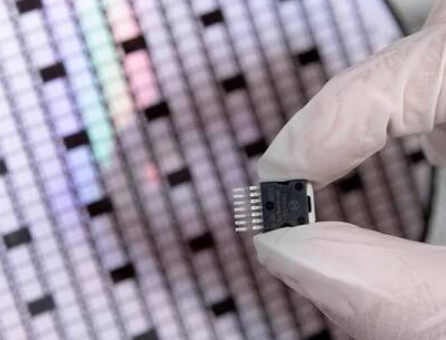- Ameya360 Component Supply Platform >
- Trade news >
- China's SiC capacity is expected to account for 50% of the world's share in 2024
China's SiC capacity is expected to account for 50% of the world's share in 2024
As reported by Taiwanese media, there’s a gradual uptick in TSMC’s capacity utilization lately, accompanied by a noticeable surge in orders from TSMC’s clients. Some segments of the market are showing signs of rekindled demand, hinting at a possible upswing in the semiconductor industry. Nevertheless, certain semiconductor manufacturing firms remain cautious in their industry outlook.

TSMC’s Capacity Utilization Rate on the Rise
Media’s report indicates that TSMC’s capacity utilization rate has gradually recovered. The 7/6nm utilization, which had dropped to 40% at one point, is now around 60% and could potentially reach 70% by the end of the year. Similarly, the 5/4nm utilization is at 75-80%, and the 3nm capacity, which increases seasonally, is approximately 80%.
Concurrently, TSMC is experiencing a significant uptick in orders from their clients, including tech giants like Apple, MediaTek, NVIDIA, AMD, Intel, Broadcom, Marvell, and STMicroelectronics. Furthermore, AI chip clients such as AMD’s subsidiary Xilinx, Amazon, Cisco, Google, Microsoft, and Tesla have all accepted TSMC’s plan for a price increase in 2024.
Taking Tesla as an example, they are building a supercomputer facility in Austin to accelerate the development of their autonomous driving system, expanding the computing power of Dojo. The core D1 of Dojo is produced using TSMC’s 7nm process and advanced packaging technology. Based on this, Tesla is deepening its collaboration with TSMC, and it’s expected that their order volume will increase from around 5,000 pieces this year to 10,000 pieces next year.
Amid the ongoing AI surge, NVIDIA is actively seeking additional production capacity. On October 19th, NVIDIA’s CEO, Jensen Huang, revealed in an interview that the global demand for AI chips remains robust. He has met with TSMC’s CEO, C.C. Wei, to discuss providing more capacity to serve customers. NVIDIA is in the planning stages for the next generation of chips designed for AI-based infrastructure and has also engaged in discussions with partners such as Quanta and ASUS to strategize collaboration.
Is the Semiconductor Industry on the Rebound?
During TSMC’s Q3 earnings call, C.C. Wei pointed out that, in addition to strong AI demand, there’s a rebound in demand for smartphones and personal computers. As for automotive electronics, benefiting from the continued growth of electric vehicles, the demand for next year is expected to be quite robust. Regarding when the semiconductor industry might hit bottom, Wei remarked that there are some early signs appearing in the PC and mobile phone sectors. However, it remains challenging to predict a strong resurgence as customers are still cautiously managing their inventories.
In response to industry concerns about smartphone growth, TSMC’s CFO, Wendell Huang, noted that smartphone growth is anticipated to remain lower than the company’s future growth rate. High-Performance Computing (HPC) is expected to be the most robust growth segment, making substantial contributions to growth in the coming years.
On the other hand, other semiconductor foundry companies, such as PSMC, have also shared their perspectives on the fourth quarter and future industry developments. Recently, PSMC’s President, Brian Shieh, pointed out that the supply chain’s inventory seems to have reached a reasonable level, with growing demand for mobile panel driver ICs, surveillance system CIS chips, and visibility extending beyond one quarter. Prices for special memory products have started to show an upward trend. Demand for Power Management ICs (PMIC) also displays signs of recovery, even though the trend isn’t as pronounced as that of driver ICs and CIS chips.
Regarding UMC, the company is scheduled to hold an earning call on 25th October. In their previous earnings call for the last quarter, UMC mentioned that due to ongoing adjustments in the supply chain’s inventory, the outlook for wafer demand remains uncertain. Although the industry glimpsed a modest recovery in the second quarter, the overall sentiment in the end-market remains subdued, and customers continue to maintain stringent inventory management practices.
Online messageinquiry
- Week of hot material
- Material in short supply seckilling
| model | brand | Quote |
|---|---|---|
| BD71847AMWV-E2 | ROHM Semiconductor | |
| RB751G-40T2R | ROHM Semiconductor | |
| CDZVT2R20B | ROHM Semiconductor | |
| TL431ACLPR | Texas Instruments | |
| MC33074DR2G | onsemi |
| model | brand | To snap up |
|---|---|---|
| IPZ40N04S5L4R8ATMA1 | Infineon Technologies | |
| BP3621 | ROHM Semiconductor | |
| ESR03EZPJ151 | ROHM Semiconductor | |
| TPS63050YFFR | Texas Instruments | |
| BU33JA2MNVX-CTL | ROHM Semiconductor | |
| STM32F429IGT6 | STMicroelectronics |
- Week of ranking
- Month ranking
Qr code of ameya360 official account
Identify TWO-DIMENSIONAL code, you can pay attention to


Please enter the verification code in the image below:






















